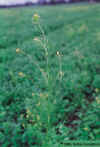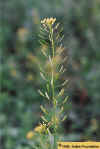
|
Oklahoma State University Stillwater, OK |
|
Oklahoma Alfalfa |
|

|
Oklahoma State University Stillwater, OK |
|
Oklahoma Alfalfa |
|
|
Tansymustard |
|
| COMMON NAME: | Tansymustard |
| SCIENTIFIC NAME: | Descurainia pinnata (Walt.) Britt |
| TYPE: | Annual Cool-season Broadleaf Weed |
| DESCRIPTION | |
| Germination: | September to October. |
| Reproduction: | By seeds in May to June. |
| Stems: | 1 to 3 feet high with many axillary stems at top of plant. |
| Leaves: | Light green, alternate, 2 to 4 inches long, appearing compound with leaflets deeply lobed to midrib. |
| Flowers/ Inflorescence: |
Produced in elongated raceme, 4-petals and sepals about equal in length, petals yellow to greenish-white. |
| Fruit: | Slender, club-like silique, seeds in 2 rows. |
FOUND: |
Tansymustard is found in cultivated fields, pastures, alfalfa fields, waste places, and roadsides. The plant is very competitive and can crowd out crop plants and reduce crop yields. A similar species, flixweed (Descurainia sophia,) is also found in the area. |
CONTROL: |
In both seedling and established stands, mustards can be readily controlled in the fall by BUTYRAC 200. However, control of mustards is borderline with spring treatments of BUTYRAC 200. Mustards can also be controlled in established stands by residual herbicides like SINBAR and VELPAR (0.5 lb/A of active ingredient) applied in January or February. |
 In Alfalfa |
Leaf |  Seed Head |
 Seed Head |
|
| Additional Tansymustard Images | ||||
| Jim Stritzke Former Alfalfa Weed Control Specialist Department of Plant and Soil Sciences Oklahoma State University |